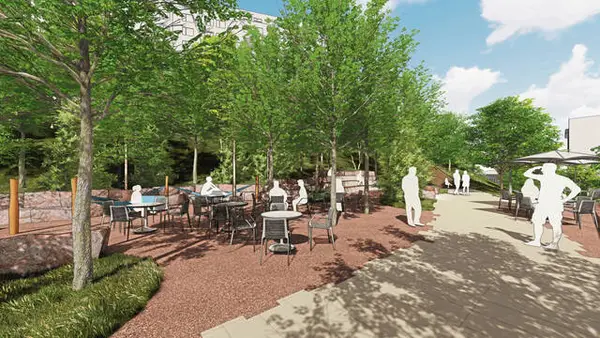Anyone who’s climbed “Cardiac Hill” for a basketball game or class at the University of Pittsburgh will tell you — perhaps after catching their breath — that having an upper and lower campus can be taxing.
That’s why Western Pennsylvania’s largest university is prepared to spend $14.5 million to make the climb in some areas less daunting and more attractive. It is the latest effort to use engineering to tame the region’s hilly terrain.
It comes as new and proposed development continues to shift Pitt’s main campus center northward from Fifth Avenue to O’Hara Street and beyond.
What leaders are calling the “Panther Overlook” project includes 2 acres of steep hillside between Utterback Drive and O’Hara Street. It’s part of the university’s master plan and will transform previously troublesome and unused terrain into a unifying pathway between the upper and lower campuses, officials said.
It will offer sweeping views and social spaces and give new value to an underused part of the 132-acre campus, which includes more than 100 academic, research and administrative buildings, as well as residence halls.
The hillside landscaping is to be completed by spring 2026 and will include social areas and seating in addition to infrastructure improvements, according to a statement from Pitt spokesman Jared Stonesifer.
“We hope the Overlook will be a tranquil place where students, staff and visitors can stroll after their day’s work is done, reconnect with nature, and seeing, hearing and feeling nothing of the bustle of Oakland,” said Mark Barnett, senior project manager at Pitt.
The project requires city review and approval.
The university’s board of trustees advanced the project last month. The work will complete the landscaping and pathways surrounding the active building projects and create vertical and lateral connections to the new facilities and to DeSoto Street, Dwayne Lee Pinkney, Pitt’s executive senior vice chancellor for administration and finance and chief financial officer, told trustees then.
It will also give students and visitors areas to relax with views of the Cathedral of Learning and beyond, he said.
The project is expected to incorporate existing and planned development, including the Campus Recreation and Wellness Center, Arena and Sports Performance Center, plus additional student housing.
A trustee resolution approving the work offered limited detail about how the portion of the hillside included in the project will be redesigned.
However, renderings from landscaping architect Mahan Rykiel Associates of Baltimore, Md. and Hong Kong, suggest there will be ascending hillside sidewalks with tables and chairs, a small amphitheater and other spots where students, employees and visitors can pause individually and in groups. The pedestrian pathways are intended to let individuals more easily navigate the vertical climb between upper and lower campus.
It will be bicycle friendly. An express elevator in the Campus Recreation and Wellness Center will provide an accessible route between O’Hara Street and Panther Overlook, officials said.
Pitt’s Hillside District comprises more than 400 vertical feet of grade change over a 68-acre site, according to the American Society of Landscape Architects. It has long been under-utilized, even as academic, residential and other uses have gobbled up space in recent years.
It will also capture stormwater from the site to reuse in campus chilled-water plants and allow reforesting of portions of the hillside to increase tree canopy.
Since Pitt opened the 12,500-seat Petersen Events Center atop DeSoto Street, the university has made increasing use of that upper portion of campus.
Pitt has disclosed plans to boost the main campus enrollment by 3,200 students, or 11%, in five years and likely will add faculty and undergraduate housing. It could bring total Oakland enrollment to 33,000.
Pitt is not the only area campus moving earth to help students, employees and visitors more easily traverse Western Pennsylvania’s hilly terrain.
Duquesne University has built gateways, including an enclosed walkway over Forbes Avenue, to connect its upper campus on the bluff and lower development including the Power Center, the campus sports arena and a new osteopathic medical school.
Carnegie Mellon University’s Gates and Hillman Centers includes a walkway linking it and the university’s upper campus including the “Cut” and Cohon University Center.
A decade ago, officials at PennWest University Edinboro (then Edinboro University of Pennsylvania) opened an elevated indoor walkway spanning 500-plus feet that carried pedestrian traffic between the east and west portions of campus, where heavy snows off Lake Erie can make for difficult pedestrian traffic.

